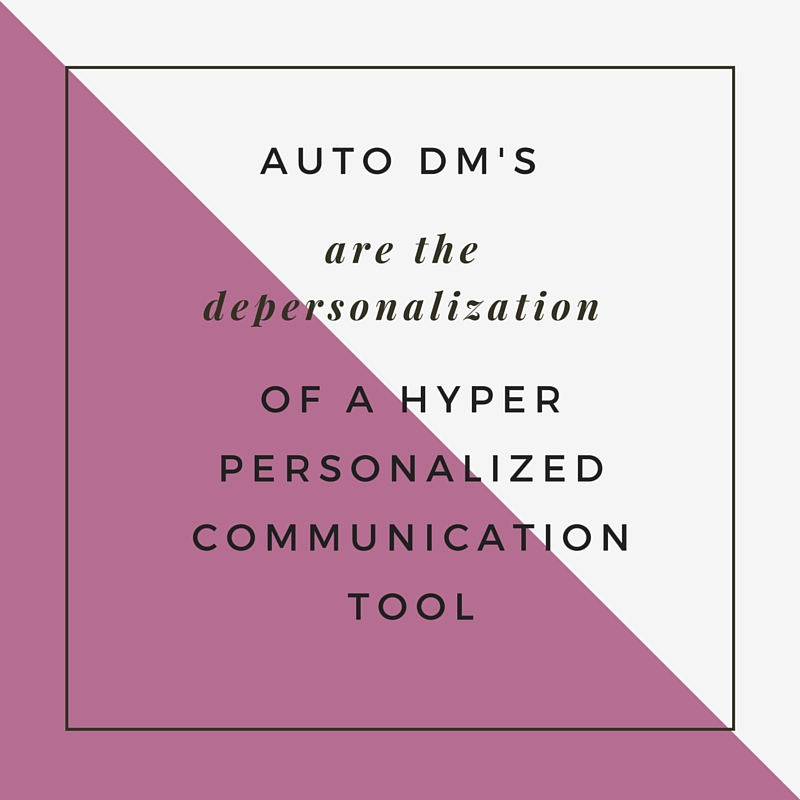Death to the Auto DM

Seriously, though, Auto Direct Messages on Twitter need to die.
It might sound like I’m being a bit harsh, or going on a Twitter rant about the number of auto DMs or Direct Messages that I receive…but when you are on Twitter as much as a marketing professional and community growth manager is on Twitter, and connecting with new people every day, they get really freaking annoying. Really professional adjectives there, I know. But it is that frustrating. Emotions of a twenty something startup marketer aside, there are legitimate reasons for not liking this once innovative tool.
When the automatic direct message, or Auto DM first appeared on Twitter, it was cool! It was an innovative growth hacking tool that made it easier for marketers and brands on Twitter to reach out and engage their brand new followers, so that they did not have to worry about missing out on that crucial moment where customer or prospect decides to give you their trust and tell you that they are interested about the content that you are throwing out into the world wide internet…much like when social media aggregators appeared on the scene and everyone scrambled to schedule every tweet and Facebook post they ever wanted to send because it saved time. But for the very same reasons, both of these tools have a negative side effect.
The Impersonalization of a Hyper-Personalized Tool
The whole point of social media is to be able to engage on a much more personal level. People initially jumped onto Facebook and the other early platforms to be able to keep with their friends and family, to meet new people and as brands joined the conversation, to interact with the companies and brands that they loved.
Conversely, brands joined social media channels because these were the places where their customers were having conversations and spending their time. Think of when TV first came out and began to be adopted by every household. Brands were advertising on radio because that was the most cost effective way to reach their customers when they were engaged, or listening. Then TV grew and they were in every home. Brands realized that users were now tuned into a new type of media and began advertising there. With the growth of the internet and the heavy utilization of social media, it was only natural for companies to adopt this same strategy.
Social media users did not reject the presence of their favorite brands on the social media channels they loved because it gave them a direct line of communication to the people, the humans who worked at those companies. Before, every interaction that they had with a company or brand was with their advertising, or at best a 1-800 number where they reached a call center or an employee in a store that sold whatever products they were using. Then it was a generic email. Until social media, customers were very disconnected from the the decision makers in a company. The very nature of social media empowers the customer. Radio, television and even internet advertising up until this point was still one way. The people or users who viewed these ads were relegated to a very passive role.
With the ability for users to engage and be vocal on social media, and the potential for their messages to spread to a very large audience, the users were for arguably the first time empowered. One small negative interaction with a brand could be spread to a very large number of people, the conversation could snowball into a whole community speaking negatively about a company, product or brand. On the other hand, a good interaction could grow to the same magnitude. So now companies and brands are realizing the power of social and recognizing that because of user behavior, they now need social media on top of a website.
Where does this leave the Auto DM?
Blanketing everyone who interacts with your brand with the same, impersonal message, takes a hyper-personal platform, and wastes an opportunity for a personal interaction. Now that Auto DMs have been around for a couple of years, these messages are very easy to spot. Just like when ads first started appearing, users were not trained to spot them, but now they can spot them from a mile away, users almost always know when they are receiving a DM.
The first tell is that the message is sent almost as soon as they click the “Follow” button. If they choose to follow one or two new Twitter profiles, they’re now likely to get one Auto DM for every profile that they follow.
The second Tell, stems from the diversity of your audience on Twitter. It is almost impossible to make one message applicable to every user in your audience. And to do so would make that message almost irrevlevant. If you want to avoid the risk of being irrelevent to a section of your users you are left with a generic greeting message like:
“Hey, thanks for the follow. Check out what we’re doing on our blog [Insert shortened url here]”
Not a bad message, except for the fact that your followers are getting one of these for every profile they follow. Your users might not even be checking their Direct Messages anymore because of all of the automated messages that they receive. Thank God Twitter finally made that button that marks all of your messages as read because it was getting to the point where I almost wanted to stop using Twitter.
So what do you do?
This depends on your size. If you’re a large enough company with room for it in your budget, I’d give someone who knows your company and more importantly your customers the responsibility of monitoring your social channels. Depending on your size and the success of your profiles, managing your social channels (actively posting, engaging users, and monitoring and responding) could be or should be a full time job. I say large companies, because it’s generally a bit easier as an established brand to achieve an ROI more quickly.
If you don’t have it in your budget to dedicate someone full time to this effort you have a couple of options:
- Hire an intern: younger people, while more affordable are also beneficial because they are not only actively seeking a way to complete their degree and gain experience, but they have grown up with social media and understand all of the nuances, as well as the ways they want brands to interact with them.
- Ask someone: Put out a survey and ask if there is a party in your company that is interested in managing your social media. This could be for a bump in salary or not. In one of my previous jobs, I volunteered to help manage their social media because it was a resume builder and it helped me land my next job. You might be surprised to find some upwardly motivated people that are willing to take on an extra role in order to beef up their skill set.
- Delegate it: If you do not want to open it up for applications, you could select someone in your organization for a mini promotion. Whether you are able to give them a bump in salary or not, bestowing a role like this on someone can be and is often seen as a promotion. This is especially true with your younger (20 and 30 somethings) in your company.
- Share the burden: Sometimes it just makes more sense for one department to handle this role. Marketing and Customer Service often split the role of social media management. Marketing being the one to put out a message, and customer service fielding the incoming. Even if you only have one person in marketing, customer service, or maybe you have one individual that handles both right now, this is a great person to have watch for new followers, and shoot them a quick, highly personalized “Hello”!
More questions about Twitter and Direct Messages? Send me an email – let’s chat! Maggie(at)mckeatingsolutions.com


